Please note: You are viewing
the unstyled version of this website. Either your browser does not support CSS
(cascading style sheets) or it has been disabled. Skip
navigation.
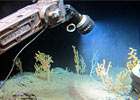 Alvin and Sentry explore the deep Gulf
Alvin and Sentry explore the deep GulfDeepwater Horizon, 2010 Principal Investigator: Tim Shank In December 2010, R/V Atlantis carried the submersible Alvin and autonomous underwater vehicle (AUV) Sentry to the Gulf of Mexico to help scientists examine deep-sea habitats near the source of the oil spill. Use of the two vehicles in tandem to identify and target sites of interest on the seafloor represented a first for deep-water exploration. 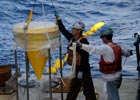 Collecting Deep-sea Sediment Flux
Collecting Deep-sea Sediment FluxDeepwater Horizon, 2010 Principal Investigator: Chris German In 2009, a group of researchers studying deep-water animals and habitats in the Gulf of Mexico set out two instruments to collect samples of the carbon-rich debris that rains down from above and that serves as food for many of the animals that live on the bottom. Both were scheduled to take their final sample on July 2 so WHOI researchers quickly mobilized to place new instruments on the seafloor and extend their record of conditions in the Gulf. 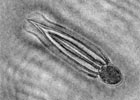 From Plankton to Oil Droplets
From Plankton to Oil DropletsDeepwater Horizon, 2010 Principal Investigator: Cabell Davis, Nick Loomis WHOI scientists deployed a specially designed camera system to identify and measure the tiny plants and animals that live in the open ocean. At the same time, they discovered that their instruments are also well suited for measuring the size and distribution of oil droplets in the water column. -This information is important to model the oil plume more accurately. 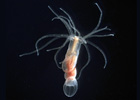 Biological Responses to Oil and Dispersant
Biological Responses to Oil and DispersantDeepwater Horizon, 2010 Principal Investigator: Ann Tarrant Based on a long history of work with the starlet anemone (Nematostella vectensis), scientists from WHOI and elsewhere have begun watching for and modeling genetic and physiological responses in the organism to the oil and the dispersants used to fight the spill. 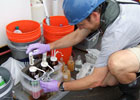 Dead Zones and Microbial Response to Oil
Dead Zones and Microbial Response to Oil Deepwater Horizon, 2010 Principal Investigator: Ben Van Mooy Water samples from the Gulf are helping scientists understand how different microbes in the ocean respond to oil spills. They found that although oil-eating microbes were limited by a lack of phosphorous in the water, they were able to consume oil at a much higher rate than expected. Last updated: July 28, 2014 | |||||||||||
Copyright ©2007 Woods Hole Oceanographic Institution, All Rights Reserved, Privacy Policy. | |||||||||||

